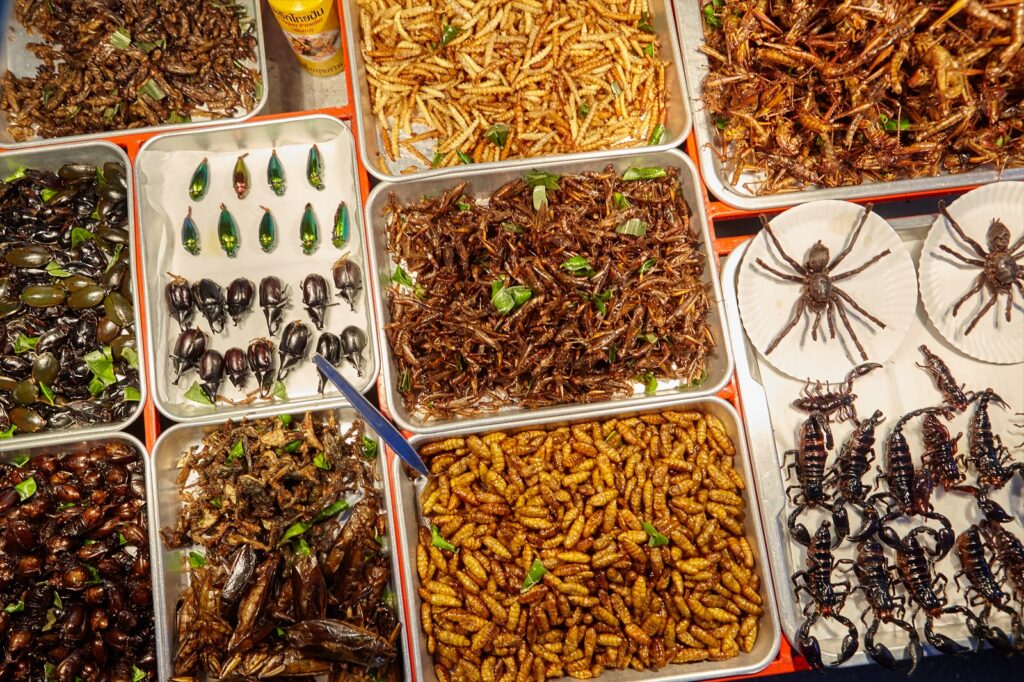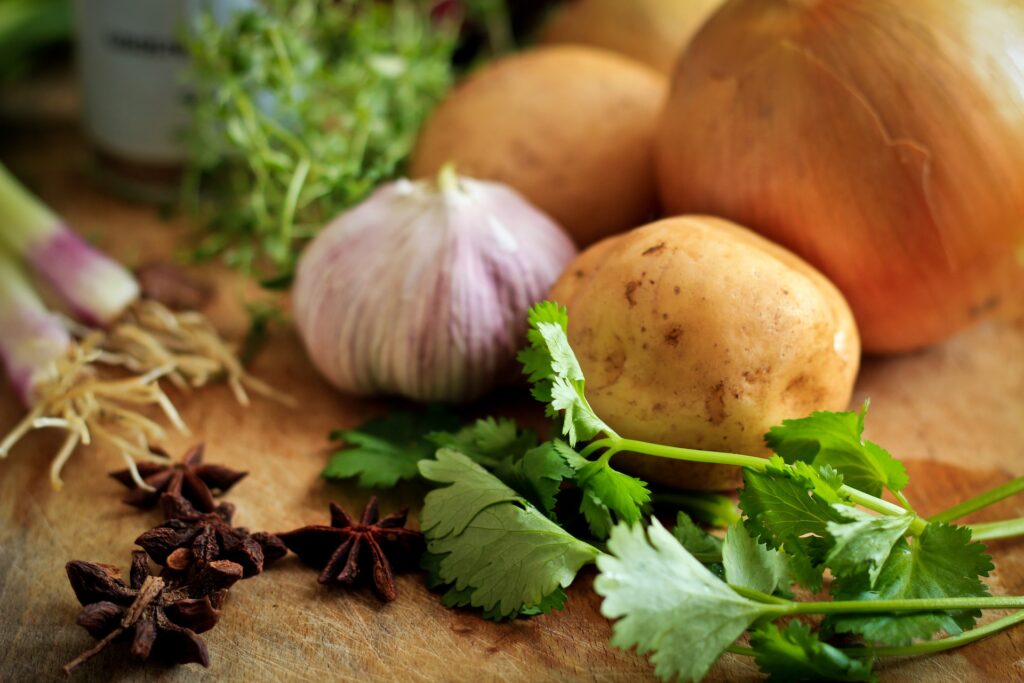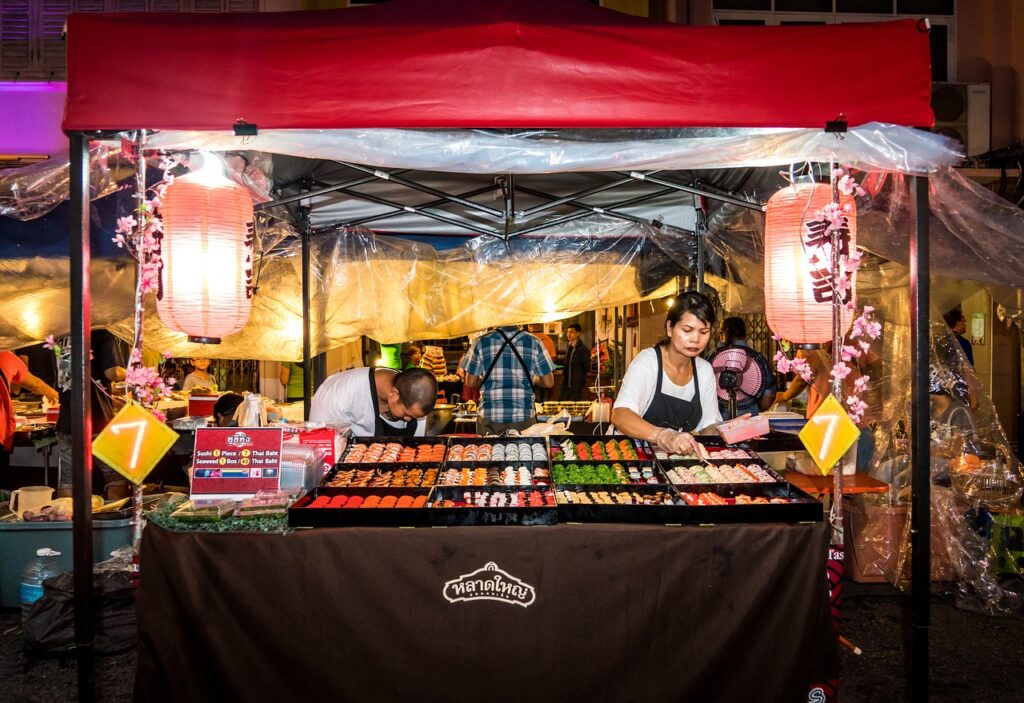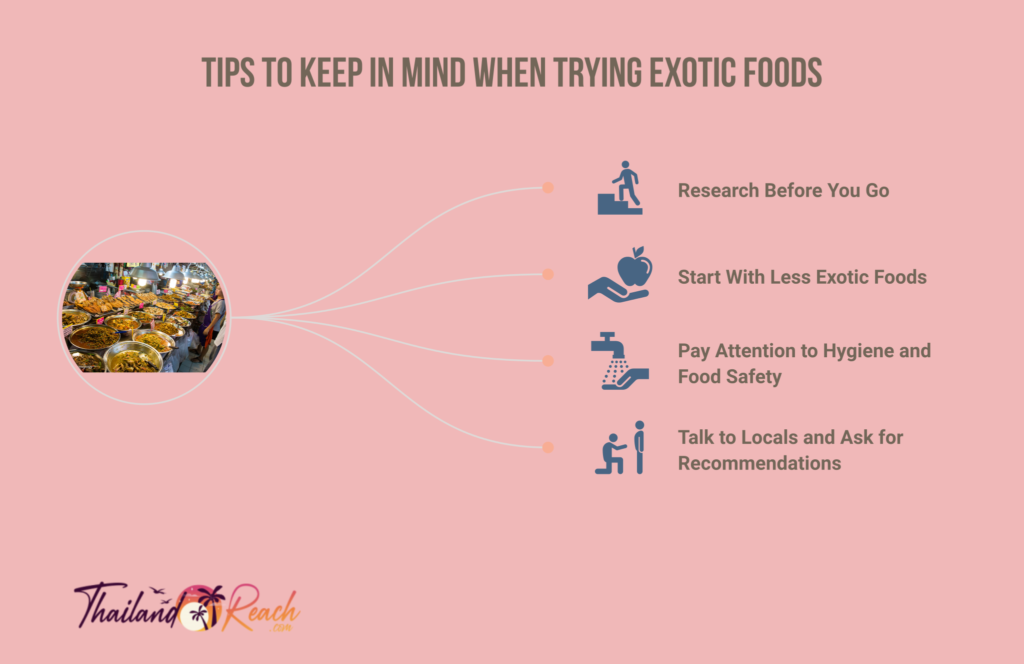Are you fascinated by Thailand exotic food? Have you ever tried something so unique and tasty that you wanted more? That was my first impression of Thailand’s unusual food. One of my favorite parts of traveling is trying the local cuisine. Thai cuisine is known for its robust flavors, aromatic herbs, and spices. Thailand has food for all tastes, from street vendors to fine dining.
Thailand’s cuisine is distinguished by its unusual components. These components generate a unique taste explosion in sweet, sour, salty, and spicy recipes.
I wanted to test Thailand’s diverse cuisine as an adventurous eater. In this blog, I’ll discuss my Thai dining experiences and recommend some must-try meals for travelers to Thailand. Thailand exotic food will impress foodies and non-foodies alike.
Popular Thailand Exotic Food

Thailand has long been renowned for its exotic cuisine, with bold flavors and unusual ingredients that tantalize the taste buds. As a traveler, I was eager to explore the many unique dishes of Thailand, including some of the more adventurous options. In this article, I will share my experience of trying some of the most exotic food in Thailand, including:
🥘Ab Ong Or (Roasted Pork Brain)
Ab Ong Or, or roasted pork brain, is a delicacy that can be found at traditional markets in Thailand. While it may not sound appealing to many, the dish is quite tasty and has a creamy texture that melts in your mouth. The brain is marinated in a mixture of garlic, soy sauce, and oyster sauce before being roasted until it is crispy and tender on the inside. Although it may be difficult for some, Ab Ong Or is a must-try dish for those seeking an authentic Thai culinary experience.
🥘Fried Scorpions
For the truly adventurous foodie, fried scorpions are a popular snack in Thailand. The scorpions are typically deep-fried and then seasoned with salt and chili powder. Although the idea of eating a scorpion may seem daunting, the taste is surprisingly mild and similar to that of fried shrimp. While not for the faint of heart, fried scorpions are a unique and memorable addition to any food lover’s bucket list.
🥘Mok Huak (Frog Tadpoles)
It is also known as frog tadpoles, an exotic delicacy in Thailand. The dish consists of small, translucent tadpoles that are typically steamed or boiled and then served with a spicy dipping exotic food sauce. While some may find the dish’s appearance unappetizing, the texture is similar to that of small jelly balls, and the flavor is surprisingly pleasant, with a slightly sweet taste that pairs well with the spicy sauce.
🥘Hon Mhai (Deep-Fried Silkworms)
Hon Mhai, or deep-fried silkworms, are a popular exotic street food in Thailand. The silkworms are typically fried until crispy and then seasoned with salt and garlic. While eating a worm may be off-putting to some, Hon Mhai is a crunchy and flavorful snack often compared to potato chips. Deep-fried silkworms are worth a try for those looking to expand their culinary horizons.
🥘Baak Bpet
Also known as Fried duck beaks, it may sound strange to some, but they are a popular snack in Thailand. The beaks are first cleaned and boiled before being deep-fried until crispy. The result is a crunchy, flavorful snack often served with spicy dipping sauce. While the beaks themselves don’t have much meat, they are still worth trying for their unique texture and taste.
🥘Chingrit (Crickets)
Crickets are a common street food in Thailand and are often fried or roasted before being served. While the thought of eating a cricket may be off-putting to some, they are quite tasty and can be compared to popcorn in terms of texture and flavor. They are also high in protein and low in fat, making them a healthy snack option. If you’re feeling adventurous, try Chingrit – they might just surprise you!
🥘Mang Da (Giant Waterbugs)
Mang Da, or giant waterbugs, is another exotic food in Thailand. They are typically caught in rivers and ponds and can be fried or cooked in a spicy soup. While eating a bug may not appeal to everyone, mang da is quite delicious. The bugs have a nutty and slightly sweet flavor, and their shells are crunchy and edible. They are also believed to have numerous health benefits, including aiding digestion and improving heart health.
🥘Takatan (Grasshoppers)
Grasshoppers, or takatan in Thai, are a popular snack food in many parts of the country. They are often fried and seasoned with salt and chili powder before being served. The result is a crunchy and flavorful snack that is high in protein. While eating a grasshopper may seem strange to some, they are quite tasty and can be compared to potato chips in terms of texture and flavor. If you’re feeling brave, try takatan – it might become your new favorite snack!
These are just some of the many exotic foods found in Thailand. From roasted pork brain to fried scorpions, there is no shortage of unique and adventurous dishes to try while visiting this country.
Thailand Exotic Food Ingredients

Thailand exotic food can only be complete with the diverse and unique ingredients that make up these delicious dishes. Exotic spices and flavors used in Thai cooking Thai cuisine are known for their bold and spicy flavors, which come from using exotic spices such as lemongrass, galangal, kaffir lime leaves, and chili peppers.
These ingredients are often combined with others like garlic, shallots, and ginger to create complex and flavorful dishes. For example, Tom Yum soup, one of Thailand’s most famous dishes, combines lemongrass, galangal, kaffir lime leaves, chili peppers, and other spices with shrimp and vegetables.
🌿Fresh Herbs and Their Essential Role
Aside from exotic ingredients, Fresh herbs play an essential role in Thai cooking and are used to add flavor, fragrance, and color to dishes. Most commonly used herbs include basil, cilantro, mint, and Thai sweet basil. These herbs are added to dishes last to preserve their delicate flavors and aromas. For example, Pad Thai, another famous Thai dish, is made with fresh cilantro, bean sprouts, and peanuts, which give it a refreshing and crunchy texture.
🌿Vegetarian Options for Travelers
Vegetarian travelers can still enjoy the delicious flavors of Thai cuisine; they can easily adapt to as many dishes as possible to exclude meat. Some popular vegetarian dishes include Pad Pak Ruam Mit (mixed vegetable stir-fry), Tom Yum Hed (spicy mushroom soup), and Green Curry Tofu (tofu in green curry sauce). These dishes are made with fresh vegetables, herbs, and spices and are as flavorful and delicious as their non-vegetarian counterparts.
Thailand’s exotic food ingredients create a unique and unforgettable culinary experience. Every ingredient plays an important role in Thai cuisine, from the bold spices and flavors to the fresh herbs and proteins. Whether you’re a meat lover or vegetarian, there is something for everyone to enjoy in Thailand’s vibrant food culture.
Thailand Exotic Street Food

As a traveler who loves exploring new cultures, trying local food is something I always look forward to. Street food is an essential part of the culinary scene in Southeast Asia, and Thailand is no exception. From savory noodles to sweet desserts, Thailand’s street food scene offers something for every palate. In this article, I will share my personal experience and opinion on some of Thailand’s most popular street foods.
🍤Pad Thai
Pad Thai is one of Thailand’s most famous Thai dishes and an essential street food. This stir-fry dish consists of rice noodles, scrambled eggs, tofu, shrimp, bean sprouts, and peanuts, seasoned with tamarind paste, fish sauce, and palm sugar. The result is a perfect balance of sweet, sour, salty, and spicy flavors that create an explosion in your mouth. You can find Pad Thai at nearly any street food market in Thailand. It is often served with a wedge of lime and chili flakes on the side to adjust the seasoning.
🍤Satay
Satay is a popular street food snack in Thailand, especially in the southern region. It is made by skewering marinated meat (usually chicken or pork) and grilling it over charcoal until it is cooked and slightly charred. The meat is served with a peanut dipping sauce that is creamy, nutty, and spiced with chili. Satay is a perfect snack to grab on the go or as an appetizer before a meal.
🍤Pad See Ew
Pad See Ew is a popular noodle dish in Thailand that is often eaten for breakfast or lunch. It consists of wide rice noodles stir-fried with soy sauce, garlic, Chinese broccoli, and egg. Some vendors add pork or chicken to the dish for extra protein. Pad See Ew has a unique smoky flavor from being cooked over high heat. This dish is a must-try for anyone who wants to taste the authentic flavor of Thai street food.
🍤Khao Niew Ma Muang
Khao Niew Ma Muang, also known as Mango Rice, is a sweet and refreshing dessert perfect for hot weather. It consists of glutinous rice cooked with coconut milk and sugar and sliced ripe mango. Some vendors add salt to the rice to balance the sweetness. The result is a creamy, chewy, and fragrant dessert that leaves you wanting more.
🍤Kai Jeow
Kai Jeow is a simple yet satisfying Thai-style omelet often eaten for breakfast or as a snack. It is made by whisking eggs with fish sauce, garlic, and pepper, then frying the mixture until golden brown. Kai Jeow is usually served with steamed rice and sweet chili sauce. The omelet is fluffy and flavorful, and the chili sauce adds a spicy kick to the dish.
🍤Som Tam
It is a green papaya salad, a refreshing and healthy dish popular among locals and foreigners. It is made by pounding shredded green papaya with chili, garlic, fish sauce, lime juice, and palm sugar in a mortar and pestle. The result is a salad that is sweet, sour, salty, and spicy all at once. It can be served with sticky rice and grilled meat.
🍤Poh Pia Tod
Poh Pia Tod are a crispy and savory street food snack perfect for munching on while exploring the markets. They consist of vegetables such as cabbage, carrots, and bean sprouts, rolled up in a thin wrapper and deep-fried until golden brown. Poh Pia Tod is often served with a chili dip sauce that complements the crispy texture of the rolls.
Traveler’s Tips for Trying Thailand Exotic Foods

Now that you know some of the must-try street foods in Thailand, here are some tips to keep in mind when trying exotic foods.
❕Research Before You Go
One of the best ways to prepare yourself for trying new foods is to research before you go. Look up popular dishes and ingredients in Thai cuisine, and familiarize yourself with the names and flavors of different spices and herbs. It will give you a better understanding of what to expect when facing a menu full of unfamiliar dishes.
❕Start With Less Exotic Foods and Work Your Way Up
When trying exotic foods, it’s best to start with less intimidating dishes and work your way up to the more exotic ones. For example, Pad Thai and Tom Yum are both popular dishes that are fairly mild in spice and flavor. Once you’ve tried these dishes and become more comfortable with the flavors and textures of Thai cuisine, you can start to branch out and try more adventurous dishes.
❕Pay Attention to Hygiene and Food Safety
Hygiene and food safety should always be a top priority when trying street food in Thailand. Look for vendors who are busy and have a high turnover of food, as this means that the food is likely to be fresh. Also, pay attention to how the food is prepared and stored. For example, meat should be cooked thoroughly, and you should wash raw vegetables in clean water before being used in dishes.
❕Talk to Locals and Ask for Recommendations
One of the best ways to discover new and exciting street food in Thailand is to talk to locals and ask for recommendations. Thai people are known for their love of food and will be more than happy to share their favorite dishes and street food vendors with you. Strike up a conversation with a vendor or a local person and ask for their suggestions – you might just discover a hidden gem that you wouldn’t have found otherwise.
Trying exotic foods in Thailand can be a rewarding and delicious experience if you approach it with an open mind and follow these tips. Do research, start with less intimidating dishes, prioritize hygiene and food safety, and talk to locals for recommendations.
Frequently Asked Questions
Are insects commonly eaten as exotic food in Thailand?
Yes, insects are considered a popular and exotic food in Thailand. They are often sold as street food snacks and can be found in various forms, such as fried crickets, grasshoppers, and beetles. While eating insects might seem strange to outsiders, it’s a common practice in many parts of the world, including Thailand.
Are there any regional variations in Thai exotic dishes?
Yes, there are many regional variations in Thai exotic dishes. Each Thailand region has unique cuisine and ingredients that reflect the local culture and environment. For example, the northern region is known for its spicy and sour flavors, while the southern region is famous for its seafood dishes.
Are there any traditional Thai rituals or customs associated with exotic food?
Yes, many traditional Thai rituals and customs are associated with food, including exotic dishes. One example is using banana leaves to serve food, which is believed to add flavor and aroma to the dish.
Are there any Thai food festivals that showcase exotic dishes?
Yes, several Thai food festivals showcase exotic dishes. One example is the Bangkok Street Food Festival, which features many street food vendors selling everything from spicy noodles to sweet desserts.
Can I easily find exotic food in Thailand, or is it limited to specific regions?
Exotic food can be found all over Thailand, but certain dishes may be more prevalent in specific regions. For example, insect snacks are more commonly found in the northern regions of Thailand. However, overall, exotic food is readily available throughout the country.
What are some Thai exotic desserts or sweets?
There are many delicious exotic desserts and sweets in Thai cuisine. One example is mango rice (sticky), made with sweet glutinous rice, fresh mango, and coconut milk. Another popular dessert is Khanom Chan, a multilayered cake made with rice flour, coconut cream, and sugar.
Are there any etiquette rules I should follow when trying Thai exotic food?
When trying exotic Thai food, it’s important to respect the local culture and customs. Some general etiquette rules to follow include:
- Using utensils instead of your hands.
- Not wasting food.
- Being open-minded about trying new and unfamiliar dishes.
Final Words
Thailand’s exotic cuisine is a feast for the senses and an unforgettable experience for any traveler. From the bustling street food stalls to the high-end restaurants, there is no shortage of delicious and adventurous dishes to try. As someone who has traveled to Thailand and experienced its vibrant food culture firsthand, I can attest that the country’s exotic cuisine is not only delicious but also a reflection of its rich history and diverse cultural influences. Trying new and unfamiliar foods can be intimidating, but it’s worth stepping out of your comfort zone to discover Thai cuisine’s unique flavors and textures. So if you ever have the chance to visit Thailand, indulge in the exotic food scene – your taste buds will thank you.
